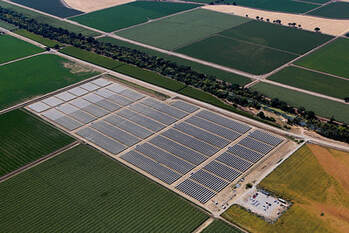By Sarah Lozanova, Solar Energy Copywriter As solar energy deployment increases, solar farms are becoming bigger than ever before. Large-scale solar farms have ground-mounted solar panels. Therefore, the way developers plan and manage those impacts wildlife and local ecosystems. How can solar professionals minimize the ecological impacts of solar farms? It is essential to examine this question throughout all phases of solar farm development, from the initial planning phase to decommissioning. Alternatives to Mowing It is critical to minimize or eliminate shading on solar panels to boost electricity production. Therefore, many solar farm managers mow around the solar panels with gas-powered mowers and use herbicides. Unfortunately, these produce carbon emissions, burn fossil fuels, and contaminate air quality and water quality. Using sheep to graze around the solar panels reduces or eliminates the need to mow and apply herbicides. Sheep are excellent at removing vegetation, even between solar panels. This prevents shading without chemicals or gas-powered equipment. Encouraging Wildlife Often, solar farms contain non-native plants or even gravel around the solar panels. This groundcover provides little value to wildlife, especially pollinators. Planting native wildflowers can help reduce the need to irrigate the groundcover, conserving water. Likewise, it gives fodder to pollinators. Once established, this landscape can reduce maintenance, saving money. Also, pollinators can provide a lot of value to farmers. If there are agricultural farms located nearby, native plants can help maintain pollinator populations, which can sometimes help protect crop yields. Promoting Soil Health Grazing sheep, cultivating native plants, and not apply herbicides all help maintain soil quality. In fact, soil health is critical for healthy ecosystems and productive farms. Solar farms may become cropland or wilderness areas after the solar farm is decommissioned. Thus, promoting soil health can help promote productive use of the property several decades from now. Preventing clear cutting Unfortunately, some properties are clear-cut to construct a solar farm. Sometimes, this involves removing mature trees. Therefore, whenever possible, it is best to site solar farms on properties that are already clear and to help keep forested properties intact. With few development options, capped landfills are an excellent place to site a solar farm. Recycling solar panels and equipment The design life of solar panels is roughly 25 to 30 years. When solar farms are eventually decommissioned, the solar panels could end up in a landfill. To conserve resources and protect groundwater, it is critical to recycle solar panels. In the meantime, it is essential to create a recycling infrastructure that can handle the looming e-waste issue from solar panels and equipment. Maintaining the solar farms Reducing the use of fossil fuels and utilizing renewable energy is critical to mitigating climate change. Therefore, it is essential to get as much solar electricity from existing solar farms as possible. Proper solar farm maintenance helps ensure this is happening. For example, if equipment fails, it needs to be replaced immediately, so the system returns to optimum production. In addition, solar system monitoring makes it easy to identify production issues and remedy them. Likewise, preventing shading on the panels is also essential for solar energy production. Read More... More Articles By Sarah Lozanova, Solar Energy Writer: How Much Does a Home Solar System Cost? Guide to Free Solar Panels Do Solar Panels Increase Home Value? What is a Microgrid? Shopping Guide: Best Solar Panels  Sarah Lozanova is a renewable energy copywriter and solar marketing specialist that uses digital marketing campaigns to drive results. She has an ability to gain media attention, boost website traffic, and engage interest on social media platforms. Lozanova connects solar energy companies to their target markets, by raising visibility, then hooking and engaging readers to request more information or take next steps. Her renewable energy writer experience includes residential and commercial solar energy, battery energy storage systems, electric vehicles, and utility-scale wind energy, and she is the author of Humane Home: Easy Steps for Sustainable & Green Living. Sarah Lozanova holds an MBA in sustainable management from Presidio Graduate School and resides in Midcoast Maine. |